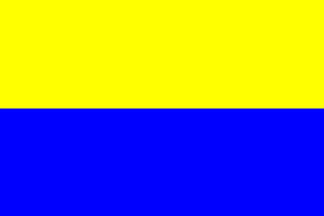![[Provincial flag of Gelderland]](../images/n/nl-ge.gif) image by
Mark Sensen, 4 May 1999
image by
Mark Sensen, 4 May 1999
Last modified: 2014-06-28 by andrew weeks
Keywords: gelderland | netherlands |
Links: FOTW homepage |
search |
disclaimer and copyright |
write us |
mirrors
![[Provincial flag of Gelderland]](../images/n/nl-ge.gif) image by
Mark Sensen, 4 May 1999
image by
Mark Sensen, 4 May 1999
See also:
Gelderland is one of the oldest and largest Dutch Provinces. The oldest arms of a count of Gelre dates from 1190 and shows three red circles on a golden shield. The circles were replaced before 1200 by three roses. Early in the 13th century the arms were changed to a golden lion on a blue field scattered with golden rectangles. These arms indicated the military rank of the counts of Gelre. In 1339 the counts became dukes and the rectangles were removed. At the same time the lion got two tails and a crown. The arms were in the 14th century combined with the arms of Gulik (a county in present day Germany). The counts of Gulik inherited the duchy of Gelre. In the 15th and 16th century there were several wars of succession in Gelderland. Finally in 1543 Charles V combined the lion of Gelderland with the lion of Zutphen (the dukes were also counts of Zutphen). This was a red lion with golden crown on a silver shield. This combination was used until 1799. In 1802 the present arms were used by the new province. In these
.gif) International Civic Arms : http://www.ngw.nl/
International Civic Arms : http://www.ngw.nl/
"Per pale azure and or; I a lion rampant to the sinister, double-queued or, armed and langued gules; II a lion rampant sable, armed and langued gules. The shield is crested by a duke's coronet of five leaves and three diadems or, lined gules, turned up with ermine. Supporters: two lions rampant or, armed and langued gules. "
 image by Jarig Bakker, 26 January 2001
image by Jarig Bakker, 26 January 2001
In 1938 Queen Wilhelmina had reigned the Netherlands for 40 years. On that occasion a lot of municipalities paraded in front of HM with their flags, which consisted of the provincial flag with the municipal coat of arms in the canton (or something...). Those municipal flags can only be considered as 'curiosities', while the status of the provincial flags is not quite clear.
Jarig Bakker, 26 January 2001